
I was supposed to go to Luxor with Irene but due to a 24 hour stomach I slept all day and left in the evening. Irene wanted to stay with me but I insisted she go ahead and see some of the sites that were calling to me anyway and I knew she would enjoy.
Irene wrote:
It was a short flight to Luxor where I was greeted by the owner of the hot air balloon company, an Egyptian man called Ez. His assistants Leslie and Hassan were my tour guides.
We met up with the two other people who were to travel with us to Abydos and Dendera. This part of my journey had been planned by Fergany who works in conjunction with Ez. After we were safely in the van, Ez wished us a good trip then returned to his office.
We drove from the East Bank to the West Bank. This is where you find Abydos, Dendera, the Valley of the Kings, the Valley of the Queens, the Temple of Hatshepsut, and many other areas that feel like the spine of a journey set up by the creational geometry.
You can feel different chakras activating in your body as the you drive to, or near, these areas. It is as if each of them represents a different point in your chakra system.
We decided to go to Abydos first. I didn't realize that the drive would take three hours. Though I had only slept three hours the night before, as I had a 6 AM flight to Luxor, I wasn't the least bit tired. If anything I felt exhilarated as we drove to Abydos. I didn't want to miss any of the sites along the way. Leslie and Hassan were very friendly and informative.
We had to stop several times as the local police checked the buses, cars and passengers. A policeman stopped us. He told the driver that we were going in the wrong direction to Abydos.
He ordered the driver to make a U-turn even though we were on a one-way road. I couldn't believe we were going the wrong way on a one-way road, in the opposite direction of on-coming traffic. What was stranger was that nobody seemed to care. It was normal for Egypt.

Abydos is one of the oldest cities of ancient Egypt, and also of the eighth nome in Upper Egypt. It is located about 11 kilometres (6.8 miles) west of the Nile. Considered one of the most important archaeological sites in Egypt, the sacred city of Abydos was the site of many ancient temples, including Umm el-Qa'ab, a royal necropolis where early pharaohs were entombed. These tombs began to be seen as extremely significant burials and in later times it became desirable to be buried in the area, leading to the growth of the town's importance as a cult site. Today, Abydos is notable for the memorial temple of Seti I, which contains an inscription from the nineteenth dynasty known to the modern world as the Abydos King List. It is a chronological list showing cartouches of most dynastic pharaohs of Egypt from Menes until Seti I's father, Ramesses I. The Great Temple and most of the ancient town are buried under the modern buildings to the north of the Seti temple. Many of the original structures and the artifacts within them are considered irretrievable and lost; many may have been destroyed by the new construction. Read more
-
Irene continues ...
Finally we arrived in Abydos. There were only two other tourists with us in the van. Everybody else had gone to Dendera first, so we had the temple and the ruins to ourselves. To travel here is to make the sacred, energetic journey of Isis and Osiris, Initiation and Rebirth.
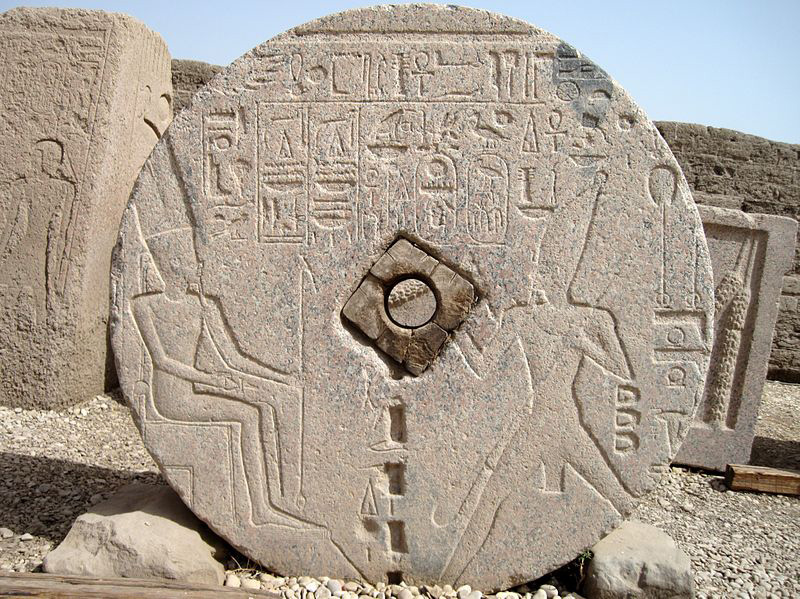
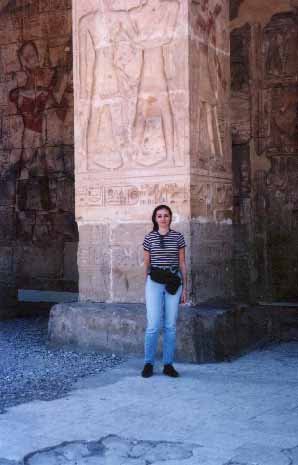
The original Temple of Osiris was built by Seti I, who came to power 29 years after the collapse of the regime of Akhenaten. Seti wished to restore the beliefs in the traditional gods and so built this temple to show his devotion. The way leading into the temple had two courts and a pylon, which were built by Ramesses II. The way these courts and pylon were positioned gave the entrance the illusion of sloping upwards. Sadly, this entrance has been mostly destroyed. The front of the temple is now 12 rectangular pillars, covered with sacred images welcoming Osiris, Isis, and Horus.

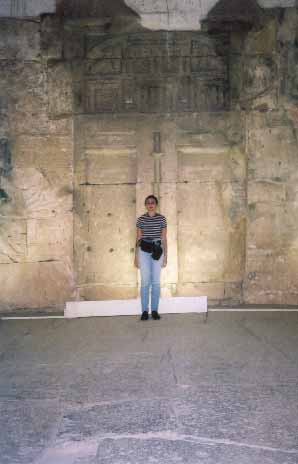
The first (outer) hypostyle hall was built by Ramesses, but the quality of the decorations on the columns are not as impressive as those found in the second (inner) hall, which Seti built. It is widely thought that Ramesses used the best craftsmen in building his own temple, but used lower quality workers on this temple after the death of Seti. Just beyond the second hall are the seven separate sanctuaries dedicated to Seti I, Osiris, Isis, Horus, Amen, Mut, and Khensu.
Originally, seven doors led to the sanctuaries, but Ramesses, for reasons still unknown, had all but one covered over. When the temple was in use, each of the sanctuaries would have contained the god's barque (sacred boat), and would have had a stele placed in front of a false door. The sanctuaries were locked and only the high priests of each god could enter, as the Egyptians believed that the gods actually lived inside their sanctuaries. The sanctuaries are highly decorated with bas-relief paintings dedicated to the several gods of the temple.
Many of the bas-reliefs in the sanctuaries still have their coloring, but the best decorations are the masterful unpainted moldings.
One scene in Seti's sanctuary shows him being crowned by the goddess of Upper and Lower Egypt, but by far the most incredible paintings are the ones found in Osiris' sanctuary. The temple also possesses a King's Gallery, a room that lists all over its walls the names of the gods along with over 70 of Seti's predecessors (minus some omitted for political reasons such as Akhenaten and Hatshepsut), making it an invaluable resource for historians.
Through the rear door of the temple is the Osirieon, the only visible tomb at this site, which was built before the main temple. Much of the damage to the Osirieon has been from flooding, as it was built at water level, yet it is not much diminished. Red Aswan granite pillars, each weighing about a hundred tons apiece, support equally massive archways.
This temple was built as a symbol of Seti's closeness to Osiris and contains a sarcophagus, though Seti was not buried here. Seti's actual tomb is in the Valley of the Kings in Luxor. This was a fairly common practice among many of the pharaohs, having "public" tombs in one location, but actually being buried in another. The Osirieon is currently inaccessible because of the rising sand and the flooding that has occurred. Excavation has been done on the south side passage, which revealed texts from The Book of the Gates and The Book of What is in the Duat. This section was begun by Seti and finished by his grandson, Merneptah. It is a complete tomb structure, all ready to receive the mummy of a king, yet it does not appear ever to have been used so.
Abydos does have a reputation for these "false tombs" or cenotaphs. Some theorists state that Abydos does not even have a single actual tomb in it, but that all the dead who have tombs at Abydos are actually buried elsewhere. The cemeteries of northern Saqqara certainly have a great number of royal mastabas, of which many have been linked to the Archaic rulers. It is very possible that actual burials of kings and high-ranking officials were carried out at Saqqara, which is near Memphis, the new court city.
Thus the monuments at Abydos are precisely that: monuments. It is fairly simple to see why this might be so. The rulers would no doubt have a desire to be buried near the place they ruled, but Abydos was also a powerful site because of its religious ties, as well as being deep in the ancient homelands.
Thus, the rulers arranged to have themselves "buried" in both places. The body at Saqqara or another site, and a cenotaph built at Abydos. Of course, the reverse could be true, with Abydos as the true burial site and all the tombs at Saqqara are cenotaphs. Or perhaps the explanation involves a little bit of both, with some rulers desiring to be buried near Memphis, and others at Abydos, but each ruler building two tombs, one in each location.
It would be rather unusual for the rulers to remain as visible as possible in their new capital during life, and then at death, simply passing from view. Thus much of the current consensus is that Saqqara is the actual burial site and that Abydos is the site of the royal monuments. The tombs at Saqqara as a whole are larger and more luxurious than those at Abydos (with the exception of the valley "temples" of Abydos which are immense and have no known Saqqaran counterparts), suggesting that Saqqara is the true burial site. Yet there are a large number of subsidiary tombs at Abydos, such as those used by officials of state, but very few at Saqqara. And Saqqara is the home of the most famous of the false tombs, the Third Dynasty step pyramid of Sekhemkhet, which remained sealed even to 1955, when the seals were pierced and it was discovered to have always been empty. It is a question that may not be easily resolved.
The temple of Ramesses II is a small temple that is northwest of the Temple of Osiris about 300m. The temple was built in 1298 BC for Ramesses' spirit to give him a close association with Osiris. It was originally built very well and contains work that is better than most of Ramesses' other monuments. The craftsmen were probably trained during his father's, Seti I, era. The temple is mostly in ruin except for the limestone walls which still contain brightly colored works. Napoleon's archaeologists reported that the temple was almost intact when they first saw it.

Abydos was an important place of pilgrimage for the Egyptians. They wanted to be buried as close to Osiris as possible, and when they could not be buried at Abydos, they sometimes raised a stele there bearing their name and titles. The area was very serene and peaceful. I walked around the Temple and listened to stories Hassan
was telling me about the history of the temple.
After Abydos we went to Temple of the Goddess Hathor at Dendera. On the way to Dendera I meditated. I don't remember seeing anything, I think I fell asleep for 15 minutes. Leslie was quiet also she became tired.
Abydos, like all other sacred sites, is linked to another series of metaphors for the sacred geometry, need for one's spiritual awakening.
When it was time to leave, I didn't want to go. I could have stayed for at least one day. I hoped that I had made the soul connection that had had drawn me so strongly to Abydos and these temples. Part of my soul belong here. Was it a link with Isis? the Egyptian priesthoods? the energies of the geometry?
In 1996, when I first met Ellie, and she did her first reading for me, she saw a connection between myself and Abydos, and that one day I would travel to Egypt to find that part of my soul. At that time I never thought I'd travel that quite so far.
Last spring, when Ellie wrote that she was going to Egypt, my soul connected and I immediately called and told her that I know I belong on her journey. far.
While waiting for other people to finish their tour of the temples, I took some time alone. I walked in the little park in front of the Abydos Temple. There I found a small stone circle in the middle. Something pulled me to walk around that circle counter-clockwise, three times. Ellie was not around to help me to understand what is going on. I was on my own.
The drive to the Temple of Dendera took about one and a half hours. The countryside along the Nile brought visions of ancient times and civilizations ...now lost in the sands of time. Sadness swept over me, as if the land echoed my sentiments. The history of Egypt has been written and rewritten and yet her majesty is felt everywhere.


At Dendera once again there wasn't enough time to experience everything. I didn't feel as connected as I had at Abydos but the temples had powerful energies. There are many different temples in Egypt that honor the Goddess Hathor. Like the Goddess Isis, Hathor represents, and triggers creational, feminine energies.
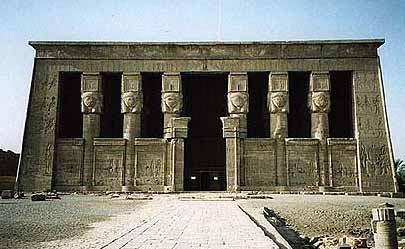

This temple is also designed basic on certain geometric patterns. John Anthony West had explained the mathematics to us the night before. Now here I was experiencing the geometry in person. Since returning to the US, John and I have emailed and I have ordered his books as I feel there is more to glean from his writings.
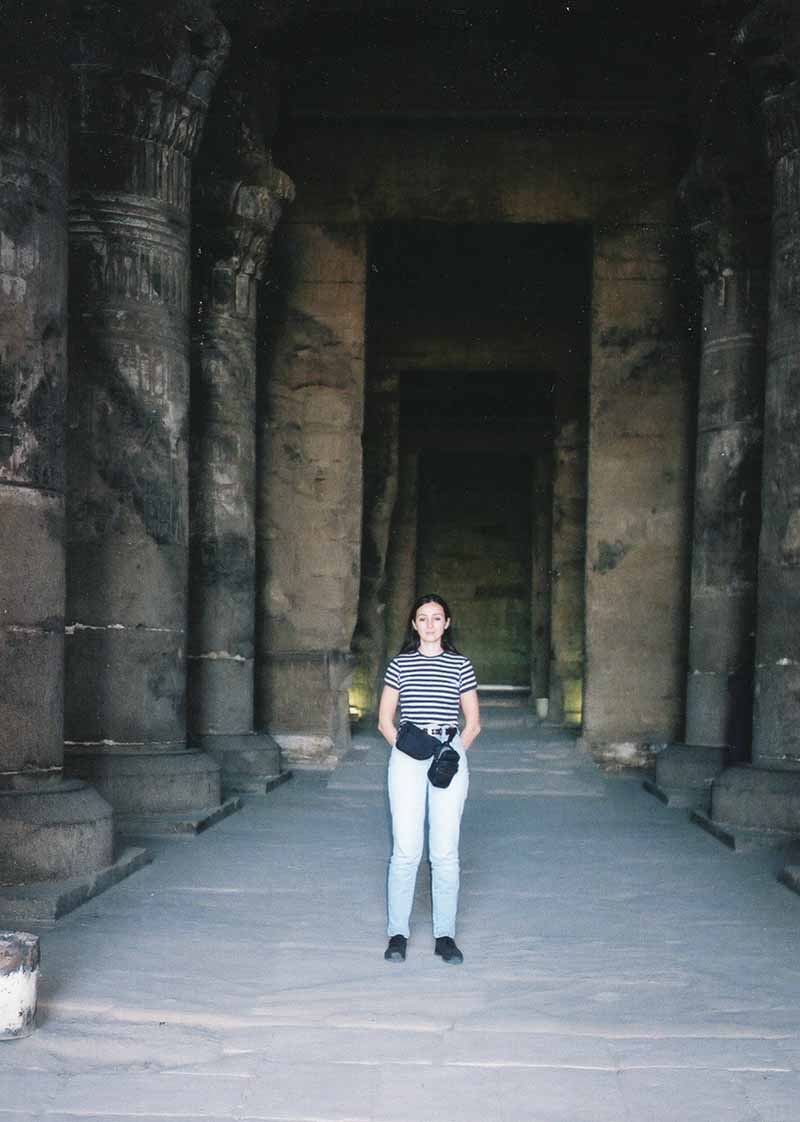
The Columns of Hathor as a Cow Goddess
Hathor was the goddess of peace, love, happiness, music, and dance. Hathor's head forms the top of the 24 columns in the Temple of Hathor at Dendera. The inner sanctuary of the Temple of Hathor at Dendera is surrounded by rooms and chapels used to store religious items and prepare for festivals. The Egyptians believed that if they mistreated Hathor, she would make everyone unhappy so no one would want to dance or sing.


It is thought this is the Roman Bird house is where Hathor gave birth to her son. It was the last birth house built in Egypt. The ruins in front of it are a birth house from the 30th Dynasty it was built about 300 years earlier. The Chapel of the New Year, which is situated just to the right of the Sanctuary in the Temple of Hathor. It was opened only once each year during the new year festival.
The ceiling is decorated with vultures, winged disks, and the union between Hathor and Horus. The colors are beautiful and are mostly still original. The rest of the ceiling is a symbolic representation of the north and south halves of the sky, the hours of day and night, and the regions of the moon and sun. The bays to the right show the northern stars while the left shows the southern stars. The figures of Nut dominate each end of the hall. The continuing cycle of a day is represented by Nut. Her dress is the sky; between her legs is the birth of the sun, which disappears at night as she swallows it. The second band shows the stars, planets and symbols of the Roman zodiac. The bands on either side of the center show the course of the moon and sun.
The facade of The Hypostyle Hall is closed by a screen wall that exposes the ceiling and the capitals. Unlike previously seen capitals, these are square and are carved to resemble Hathor's face. The king is depicted on the interior walls wearing the crown of Lower and Upper Egypt.
The Hall of Appearances was built by the Ptolemies. Scenes on the walls show the king emerging from the temple, breaking the earth for the foundation, and placing the first stone. He then dedicates the foundation deposit bricks to Hathor. The hall is surrounded by six rooms. The treasury room contained holy objects made of metal. The Nile room provided an exit for the priests to go out and bring in water. A smaller room was for the convenience of the priests. This room allowed them to move between rooms easier. Another room was for the priests to make and store incense and perfumes. Room number five was for storage and room number six had an outside exit. This room was for bringing in food and drink for festivals.
The Hall Of Offerings was originally the entrance into the temple proper. Lighted only by four ceiling vents, the priests would lay out the offerings for the gods. The back wall displays the items required for the offerings, while the opposite side displays the king offering Hathor drinks. The Hall of Offerings contained a small chapel used for sacrificial offerings.
The Hall of Ennead is immediately in front of the sanctuary and contained statues of the gods and kings that took part in the ceremonies. The south wall contains texts of the hymns of awakening.
The Sanctuary contained the statues of Hathor, her barque, and Horus. The walls depict the awakening, bathing, anointing, and feeding of the goddess. Miniature barques (that were placed in real ships) are also featured on the walls.
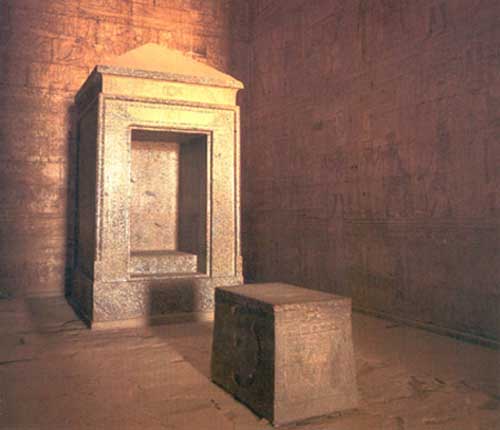
In Egyptology, naos refers to that which is hidden and unknown inside the inner sanctum of a temple, but also to little boxlike shrines, carried by statues etc. This naos is where the statue of the goddess Hathor was kept. It stands in the innermost sanctuary of the temple. I felt very strong energies when I was standing near it. Again my emotional body filled with great sadness.
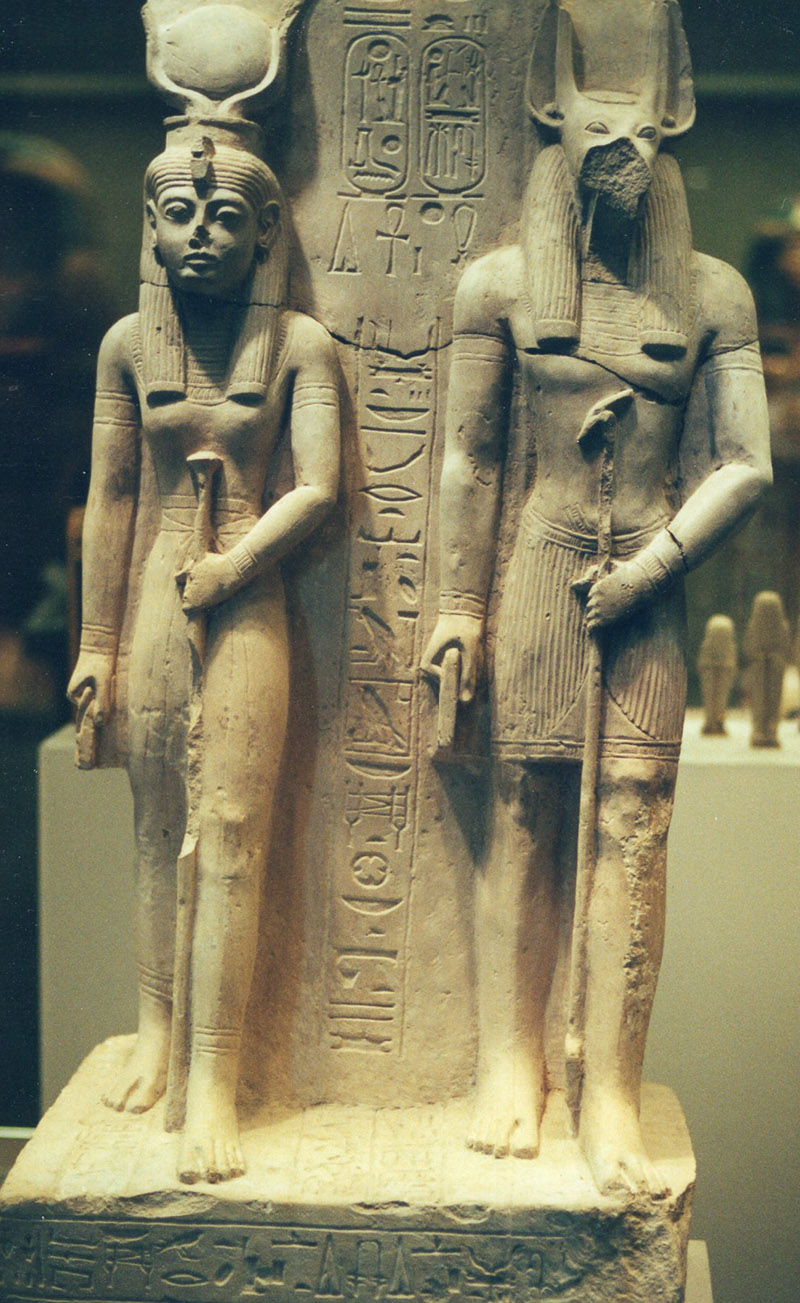
Hassan explained that the Great temple most of the images of Hathor had been destroyed by the Christians. He asked security guide to let us in underground passage under the temple. I don't think tourist are normally allowed to go there, because it was very difficult to get in. Very small opening. When we've got there I was scared, because the ceiling was very low and bats were flying. It was dark, almost black, from a fire. Within this passage were great images.
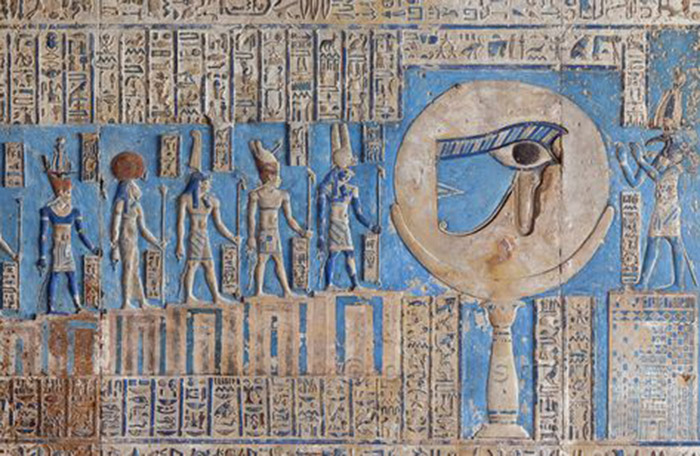
Horus
Roof of the Temple
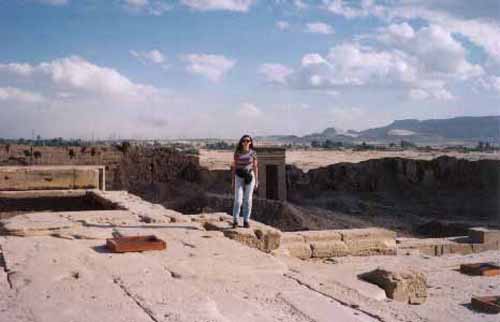
Relief of Bes
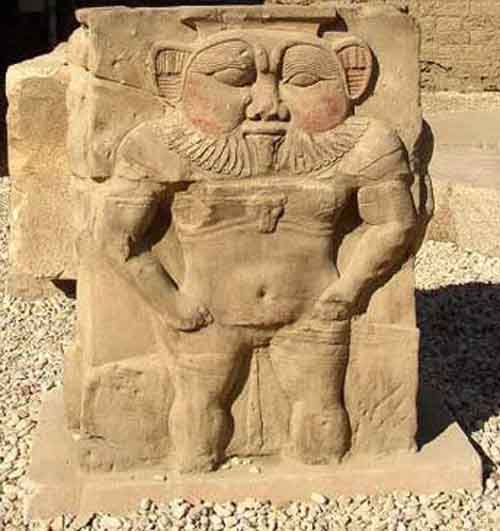
This painted raised relief of Bes sits near the Roman Gate (back left) of the Temple of Hathor at Dendera. Bes is the Egyptian household god who protected mother and child during childbirth. He is a bow-legged muscular dwarf with a ferocious facial expression. His guardianship role was suited to his appearance, which was supposed to frighten away evil spirits.
Bes provided protection for the common folk, royalty, and even deities. This image of Bes is near the mammisi, the birth house/temple of the minor god, Ihy [pronounced ih-hee], the son of Hathor and Horus (see The Temple of Horus at Edfu). Ihy is also known as Horus-Sematawy [pronounced sim-ah-tah- wee], "Horus Uniting the Two Lands."
Massive mud brick enclosure walls (back right) surround the Dendera temple complex, most of which was constructed during the late Ptolemaic and early Roman Periods. The area had been sacred for millennia, because ruins dating from the Old Kingdom through the Late Period have been found.
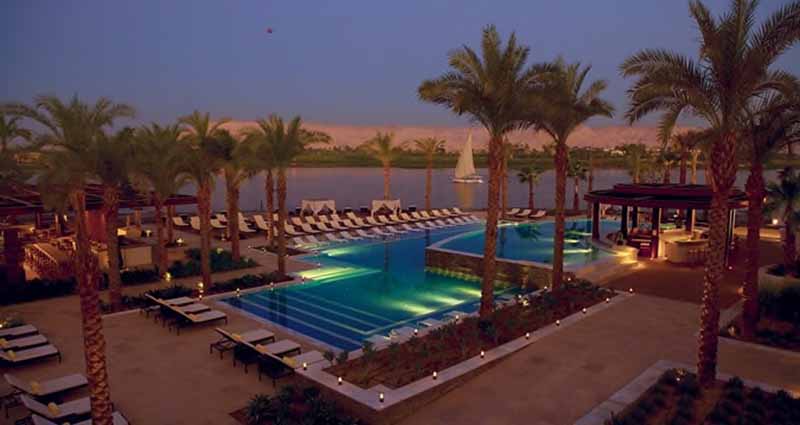
We've got back to Luxor around 5:00 PM. It was just getting dark. I checked into the Luxor Hilton, and got a room facing the Nile. The view was spectacular.
Leslie and Hassan went for 'breakfast'. Leslie said that she would pick me up at 7:45 PM to go for Light and Sound show at the Karnak.
I took a nap as I was beyond exhausted. In my dreams I saw more images that looked like hieroglyphs.
Two hours later I the phone woke me up. Fergany called to tell me that Ellie would be taking mid-night flight to Luxor. (She had gotten sick with a stomach virus and spent Saturday sleeping).
I got up and went for dinner. All of the sudden I felt very hungry. My entire trip I didn't eat much. But from that moment I couldn't stop eating for the rest of the trip. Even Ellie was making fun of me, as I never eat a lot.
Leslie came for me and we went to the Light and Sound show at Temple of Karnak was very nice. It was magic night.
The moon was two days away from being full. The energies were very strong, but peaceful. Something was shifting, though I wasn't sure what it was.
From our arrival in Egypt everything seem to be escalating for me. I was too wired to sleep or even think.
Perhaps that was part of my processing.
/Crystalinks/Ancient html/Egypt Trip/egyptripabydos.html When I left for Egypt I was uncertain about the messages I received from spirit.
Now I discovered that I was totally opening up and could 'see' and 'hear' spirit.
My energies were heightened beyond which I could imagine. I had awaited this awakening for many years, and always sensed it in my soul.
I am originally from Russia, having moved with my family to the US in 1990. My soul has journeyed to many places in this lifetime.
The energies of this trip all felt right on many levels.
I could now see myself in past lives.
My dreams were vivid. I remembered most of them. They felt like time travel experiences. I could see ancient Egypt and my part in its history.
I wanted to see and learn as much as I could in my time there.
I was back at the Luxor Hilton by 10:00 PM and tried to sleep.
The energies of Luxor were so high, I felt I could do with no sleep, but my 3D mind told me my body needed rest. Maybe I was eating so much, to keep up my energies.
The Avenue of the Sphinxes

The Light Show at the Temple of Karnak was breathtaking. Monuments come alive in brilliant light. They almost invite you to enter the sacred temple. Off in the distance you can see the sacred alter. The progression of the light and sound continues until you reach the Sacred Lake where the magnificent finale takes place while you sit silently in the grandstand. Though I would visit Karnak the next day in the daylight hours, the experience at night was clearly to awaken something within me. As we walked back to the entrance, in the dim light, the mystifying shadows lent a surreal air to the moment.
Ellie finally arrived at the hotel at 3:00 AM as her flight had been delayed in Cairo.
I heard her come in and said hello.
We didn't put on the light.
I asked if she was feeling better.
She said her virus was over and that I should try to get some sleep.
She lay down on the other bed as we both tried to rest. The energies were too high for either of us to sleep.
4:30 AM: We received our wake-up call from the front desk.
5:00 AM: We went to the main lobby we were joined by two people from England who would be part of our trip over Egypt in a Hot Air Balloon.
5:10 AM: The van came to drive us to the Nile River where we would take a ferry to the west bank. The night air was clear and quite cold. We wore several layers of clothing.
On day six I took the hot air balloon tour with Ellie. As we passed over the Temple of Hatshepsut I knew I had to go back to the west bank and experience it. Thought the temple was not on our itinerary, and we had already spent a small fortune, I knew I needed to go there. I have always been drawn to Hatshepsut - evening buying a video about her life.
After the balloon tour Ellie went to the Luxor Market with Leslie, while I traveled with Hassan. On the way to the Temple I asked Hassan why Hatshepsut chose that area for her Temple. When I got there I knew why. All I could feel were intense energies as we drove closer.
Resemblance - Irene in front of The Temple of Hatshepsut
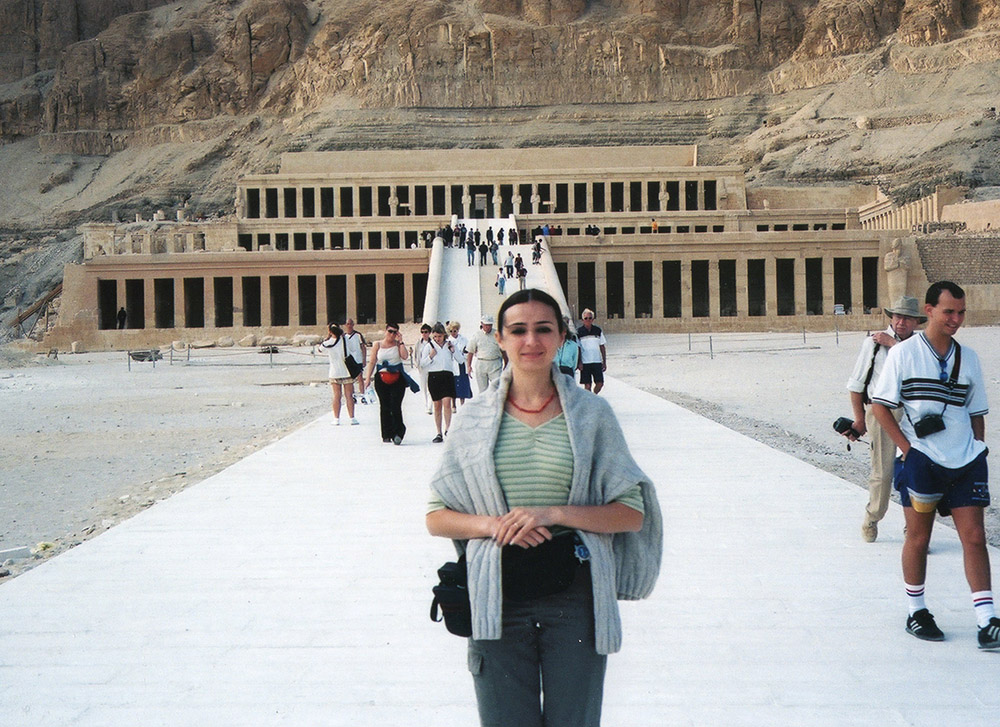

Hatshepsut's Temple was built almost inside of mountains. From this place one's energies become elevated. The view is unbelievable as you are high in the mountains. As I stood outside the temple I felt that Hatshepsut wanted to be closer to her Gods. I could feel her standing there, looking down at the valley and thinking, "This is all mine. I'm the Pharaoh of the World". Unfortunately we couldn't get inside of the temple. It is under renovation and not open to the public. Somewhere I felt connected to the frequency of this Pharaoh, the only woman Pharaoh in the history of Egypt. The allure and magic of sacred sites can be viewed from a computer, but in the flight of consciousness ascension, one must be embraced by experience and emotion.